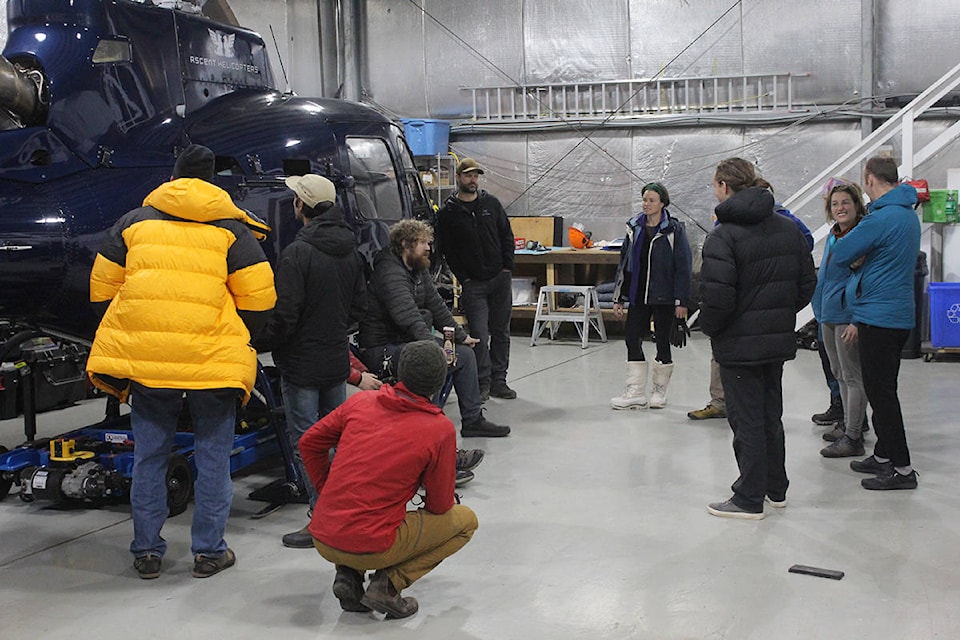A group of high-level cavers headed into the Mt. Bisaro cave system near Fernie on Saturday. The purpose of the multi-day scientific expedition, which includes videographers, was to expand the known limits of the cave system. There are currently four camps inside the cave, and getting to the camps is no walk in the park. Traversing in the cave requires precision mountaineering skills…hundreds of pounds of gear must be carefully transported to the various camps in order for the expedition to succeed.
The final camp is located adjacent to a watered-out (sump) section of cave that will require expert cave divers to penetrate further into the mountain. Leading the dangerous mission is Calgarian diver Katie Graham, who said her family thinks she is “crazy.” She has been caving for approximately 10 years.
“We found this cave in 2012,” she said. “There’s a core group of us that have been exploring this cave. We had an equipment failure while diving two years ago, so it was a pretty limited dive. We are trying to go back there with more gear, hoping that there is just a small water feature, and that we can come up on the other side, and come back into dry passage.”
With diving being the expedition objective, Graham and her diving partner carry high-tech gear with built-in redundancy in case of equipment failure or other trouble. The equipment includes a long cord that is strung in case of disorientation because of reduced visibility. The cord, and other gear, are literal lifelines inside the cave, which is no wider than a person in some places.
“We have two scuba tanks with independent first stage and second stage,” she explained. “So that is what’s fundamentally different from a normal Caribbean scuba set-up. My dry suit inflation is also a backup. We always run a line while diving. So you can follow yourself home. You should be aware and not get confused, but you have a line if you lose visibility and get disoriented.”
Graham won’t be hauling along any camping gear in case she pops out into dry passage during her unprecedented cave dive.
“It’s already complicated enough without taking any extra stuff unless it’s absolutely necessary,” she said in a tough voice. “[The gear] is buoyant and you’ve got to control that extra stuff following you. You are towing big inflatable bags. You’ve got a lot going on [down there], trying to run the line. I’m using silt screws, putting pipe in the ground, and putting on line. Then we are going to survey back.”
Adam Walker of Canmore is Graham’s diving partner. The 16 year diving veteran will be positioned for rescue.
“This is my first time in Bisaro,” he said. “My role will be support diver and backup diver to expand our safety margin to give Katie as much chance of success as possible. It gives us a bit more redundancy in terms of equipment. Dragging diving gear into the cave is hard on it. It gives us extra bits to work with. If something does happen, there’s someone in the water with her.”
Walker said the most difficult part of the expedition is the logistics surrounding the movement of gear to the far end of the cave.
“We have 15 to 20 bags to carry down,” he explained. “All 30 pounds each or heavier. Some are delicate and need to be gingerly carried. And it’s not an easy cave, so there are a lot of mules. We are all mules.”
Walker said that one of the main differences between cave diving and other forms of scuba are the strict rules around air consumption and time.
“We go by the rule of thirds,” he said. “We don’t ever extend or exceed that. We basically take the volume of air we have and divide that into thirds. You are only allowed to use one third of your air. In this case we are probably going to use even less.”
Using only one third of total air capacity means there is a very fixed turnaround point for cave divers.
“A maximum of thirty minutes,” he explained. “So If I don’t hear from her in thirty minutes, then I go and look.”
Expedition member and coordinator Jeremy Bruns said the known length of the Bisaro cave is 6.3 km in surveyed length.
“There’s still about a kilometre and a half to go and 200 metres of vertical [based on water flowing out of the mountain],” he said. “There are multiple levels in this cave and we haven’t found them all yet.”
